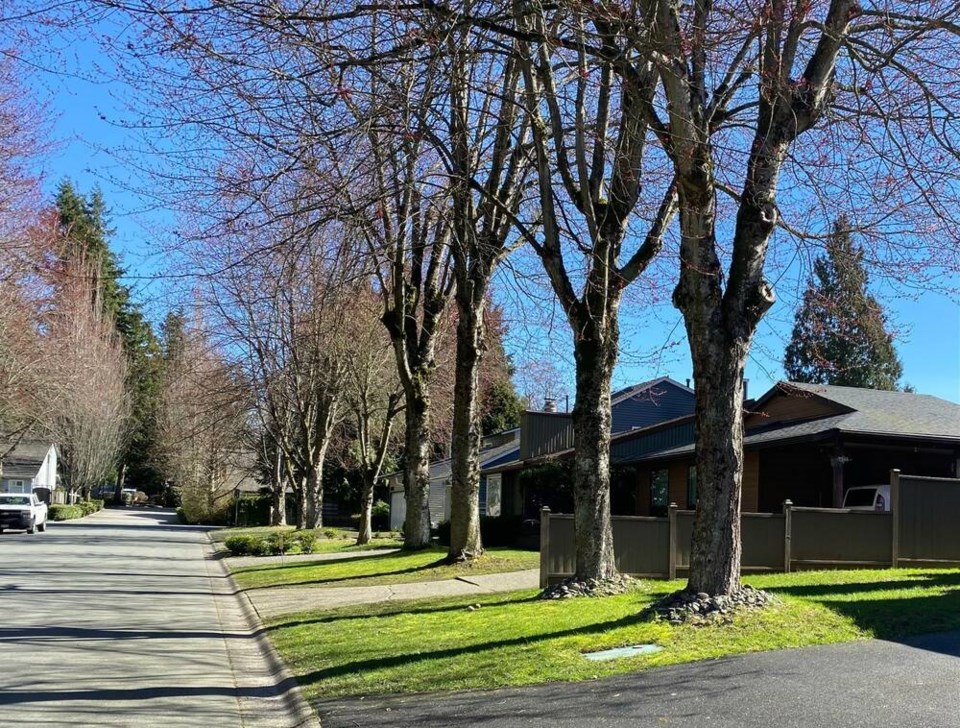The B.C. government’s housing legislation will make it even more challenging for the region to achieve its urban tree canopy target, according to a recent Metro Vancouver report.
The analysis, Tree Canopy Cover and Impervious Surface – 2020 Update, looks at the tree canopy cover in Delta and throughout the region from 2014 to 2020, finding that in 2020, impervious surfaces covered 54 percent of lands within Metro’s Urban Containment Boundary (UCB).
That represents an increase of four percent since 2014, with most jurisdictions seeing an increase in imperviousness.
The report notes that in 2020, the tree canopy covered 31 percent of lands within the UCB, representing a decrease of one percent since 2014, with the majority of jurisdictions experiencing loss, primarily associated with greenfield development and densifying urban areas.
“Increased growth and intensification pressures, as well as implementation of the new provincial housing legislation allowing greater intensification of urban lots, will likely lead to further tree canopy cover losses and impervious surface increases. However, with the implementation of progressive tree retention and urban forest expansion strategies, it is possible to offset these losses,” the report notes.
According to surface data, the most recent regional-scale data available, the City of Delta had a 20 per cent canopy cover within the UCB in 2014, but by 2019 that dropped to 19 per cent.
With the adoption of Metro 2050, a regional target was introduced to increase the total regional tree canopy cover within the Urban Containment Boundary to 40 percent by the year 2050.
If the region’s remaining greenfield lands within the UCB are developed and single-detached housing stock is redeveloped as expected over the next 20-to-30 years, tree canopy cover is projected to continue to decrease, the report notes, adding that projection did not consider implementation of the newly-adopted provincial housing legislation. It is anticipated that the legislative changes will make it even more challenging for the region to achieve the urban tree canopy target.
Municipalities, including several Metro Vancouver member jurisdictions, often use tree planting programs and policies to maintain or expand tree canopy, which can also help to offset anticipated future losses from development and redevelopment, the report notes.
However, to offset the projected decline in UCB tree canopy cover over the next 20-to-30 years, it is estimated that roughly 1,990 hectares of land within the UCB would have to be dedicated to tree planting, while an additional 8,000 hectares (a total of 9,900 hectares) of tree canopy cover would be required to achieve the Metro 2050 UCB tree canopy cover target.
The report adds more information about the pace and scale of uptake is needed to fully assess the potential impacts on tree canopy cover from the intensification of single-detached neighbourhoods and transit-oriented areas required by the recently adopted provincial housing legislation.
As far as tree removal applications to the City of Delta, the number dropped significantly two years ago.
That’s according to a staff update last fall on Delta’s Urban Forest Strategy, which notes the number of tree removal permits increased in 2020 and 2021, possibly in response to the public consultation process for the new tree bylaw. However, in 2022, when the updated tree bylaw was in effect, tree removal permits substantially decreased to 427 permits issued, compared to 1,181 permits in 2021.
The decrease may be attributed to higher tree removal permit fees and increased tree replacement requirements, particularly for large diameter trees, the report notes, adding that the internal Urban Forest Working Group has improved the tracking process for tree removals and tree plantings, allowing for faster and more accurate data reporting.
In 2024, staff will bring forward a report to council proposed amendments to the bylaw that will be aimed at streamlining and simplifying the tree removal permitting process, while continuing to protect the urban forest.
The City of Delta, meanwhile, recently once again launched its Planting Our Roots - Free Tree Project, an initiative to distribute a total of 500 trees to Delta residents at no cost, 250 in the Spring and another 250 in the fall.
City crews could also be seen throughout the city in recent weeks planting new trees in parks and other municipal areas.
It’s all part of Delta’s Urban Forest Strategy, approved by council three ago, which identifies a short-to medium-term plan (2020-2030) for “achieving a robust and sustainable urban forest in Delta.”
The strategy, part of a package of tree enhancement and protection measures, lays out the goal of 40 per cent urban tree canopy coverage, with specific targets to increase the number of trees in urban areas and along major roadways including boulevards, medians and other right-of-way areas.
Based on prior experience through the Urban Reforestation Project, an estimated 300 trees could be planted annually on Delta’s streets and boulevards, with approximately 100 trees in each community.
If that goal is achieved, over a 10-year period, 3,000 trees could be planted on municipal streets and boulevards alone.




